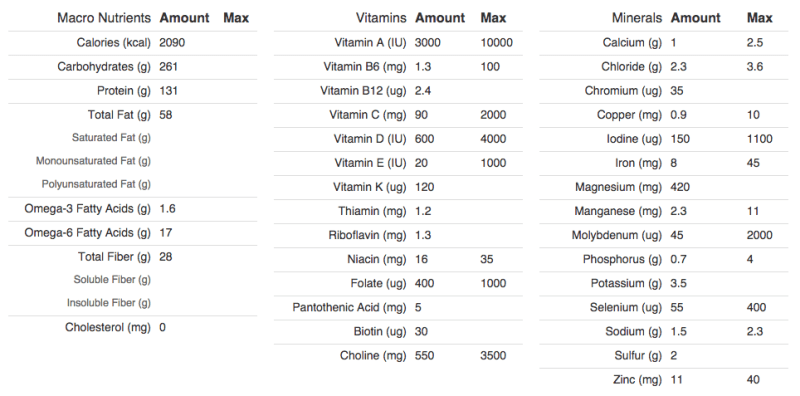Originally posted on April 30th, 2015 (more info)
Foreword
I often try and look at life through the lens of an engineer. Eating, in my eyes, has always been chaotic. You eat what you want, when you want, with very little monitoring. If you control it too much, it becomes "a diet", and it always seems so difficult to stick with rigid plans.
At some point about five years ago, I decided to try and create an all in one nutritional supplement. This is where it all started.
Nutrition as a Service (original title)
I eat unhealthily. It’s not a good thing, but my nature is to eat and I follow my nature. Over the next three months or so I’ll be conducting an experiment, upon myself. I’ll be treating my body as a consumer that requires a certain amount of nutrients. I’m going to fulfil this requirement and see what happens.
I’ll need to buy some kitchen utensils, some containers, some medical tools, and some nutrient supplies. I’ll need a precise set of micro-scales. I’ll need some containers to store my nutrient paste in. I’ll need some digital scales to get accurate weight recordings, and probably something to measure my waste & body fat ratio too. Finally, I’ll need some nutrients.
Soylent
Soylent is a US-only food substitute, giving the body everything that it needs. Unfortunately, I’m in the UK and the cost of reshipping it removes the financial incentive that it comes with. So, I’ll be looking for a DIY recipe.
Basal Metabolic Rate
The first step is to work out how much I need to eat. I’ll be using this nutrient calculator to work out what somebody of my age, size, and lifestyle needs.
For men, to calculate your Basal Metabolic Rate, the formula:
10 x weight (kg) + 6.25 x height (cm) — 5 x age (y) + 5
My weight is 75 kg, my height is roughly 178 cm, and I’m 25 years old:
10 * 75 + 6.25 * 178–5 * 25 + 25, which is:
((10×75+6.25×178)-5×25)+25
((750+6.25×178)-5×25)+25
((750+1112.5)-5×25)+25
(1862.5–5×25)+25
(1862.5–125)+25
1737.5+25
1762.5
Next we multiply base rate by between 1.2 and 1.6 depending on exercise level. I’m not doing much exercise during my experiment, so we’ll use 1.2:
1762.5 * 1.2 = 2115
Finally we reduce by 15% for Fat Loss, or 25% for Fast Fat Loss. The ‘absolute lowest’ number of calories is capped at 8 calories per pound of body weight.
The absolute lowest calories is:
165.347 * 8 = 1322.776
Gain weight steadily increases by 15%, Gain weight quickly increases by 25%.
The calculator allows you to select some macro ratios. I’ll go for moderate, which gives me 50% carbs, 25% protein, and 25% fat, with a total of 2090 calories per day.
Carbohydrate (50%) 1045 cals — 261 g
Protein (25%) 523 cals — 131 g
Fat (25%) 523 cals — 58 g
Base Recipe
This UK Soylent recipe seems to be the most popular. It seems to have a good supply of well tested ingredients. I can take this and tailor it to my requirements.
I will want to modify this to reduce the calories a bit. My plan is to buy all of the required nutrients and make a mixture. I can keep a diary of the results and improve it as I go along.
Nutrient Profile
The following is my Nutrient Profile. Based on the US government’s DRI for a male 19–50. I’ll go with this as the standard and see how I get on.
My next task will be to source some utensils and some ingredients.
Update
November 13th, 2015
I should really follow up on this to say that I did source ingredients, mix them into the DIY Soylent nutrition paste, and it tasted vile. I did two days on it, before vomiting, and throwing away the disgusting, fishy mixture.
Result: not positive.
Afterword
So I bought the ingredients above, mostly from a mixture of Amazon, Boots, and MyProtein if I remember correctly, and went about creating a batch of this dry mixture in a giant cuboid Tupperware container. Mixing it by hand was difficult and led to layers of different density particles. This was the first mistake, not mixing it in smaller batches in a spherical based container.
Now, once I had gotten what I think was a fairly well mixed dry mixture, I used milk instead of water, if I remember correctly, and allowed each drink to rest over night in the fridge. This made it less coarse. But still, it was tough.
The drink seemed to naturally have sediment, most likely the fibrous ingredients, which at the end of a drink would slide down your throat like wet sand. Add to that the fishy smell and taste, which I think came from one of the carbohydrates, and it was not pleasant at all.
I was on this supplement for about a week. At home. At work. Everyone knew about it, and were both disgusted and intrigued by it. I realised at some point I had made a terrible mistake, either with the mixture, or with the whole idea.
Some years later, I ordered a sample pack from Huel, a Soylent-like alternative. I was excited to try it, I had unflavoured and flavoured. I thought, finally, someone else has done what I could not. I prepared it, drank it, and... it tasted exactly how I had remembered it. Disgusting.
So, while I did not manage to find an all encompassing human food substitute, at least I did realise that I hadn't made a mistake when manufacturing my own.
Thanks for reading.









Top comments (1)
Dear Adam,
great first achievement and reflection on the always valuable topic on how to eat the "right" food.
After checking the NDR's, you should have a HomeKit to analyse what your body needs at the moment.
Best,
Timo